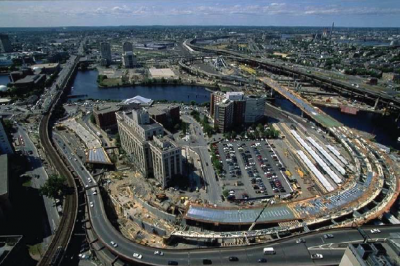Central Artery
7.8 miles of highway, 161 lane miles in all, about half in tunnels. All told, the CA/T placed 3.8 million cubic yards of concrete - the equivalent of 2,350 acres, one foot thick - and excavated more than 16 million cubic yards of soil. The larger of the two Charles River bridges, a ten-lane cable-stayed hybrid bridge, is the widest ever built and the first to use an asymmetrical design. It has been named the Leonard P. Zakim Bunker Hill Bridge.
The project also includes four major highway interchanges to connect the new roadways with the existing regional highway system. At Logan Airport, a new interchange carries traffic between I-90 and Route 1A as well as onto the airport road system. In South Boston, a mostly underground interchange carries traffic between I-90 and the fast-developing waterfront and convention center area. At the northern limit of the project, a new interchange connects I-93 north of the Charles River to the Tobin Bridge, Storrow Drive, and the new underground highway.
At the southern end of the underground highway, the interchange between I-90 and I-93 is being completely rebuilt on six levels -- two subterranean -- to connect with the underground Central Artery and the Turnpike extension through South Boston. By mid-2005 the interchange carried a total of 28 routes, including High Occupancy Vehicle lanes, and channel traffic to and from Logan Airport to the east. A fifth interchange, at Massachusetts Avenue on I-93, has been rebuilt by the project.
The project also includes four major highway interchanges to connect the new roadways with the existing regional highway system. At Logan Airport, a new interchange carries traffic between I-90 and Route 1A as well as onto the airport road system. In South Boston, a mostly underground interchange carries traffic between I-90 and the fast-developing waterfront and convention center area. At the northern limit of the project, a new interchange connects I-93 north of the Charles River to the Tobin Bridge, Storrow Drive, and the new underground highway.
At the southern end of the underground highway, the interchange between I-90 and I-93 is being completely rebuilt on six levels -- two subterranean -- to connect with the underground Central Artery and the Turnpike extension through South Boston. By mid-2005 the interchange carried a total of 28 routes, including High Occupancy Vehicle lanes, and channel traffic to and from Logan Airport to the east. A fifth interchange, at Massachusetts Avenue on I-93, has been rebuilt by the project.
Boston,
United States
- Underground Transport
- Road tunnels
US$+10bn
Project construction
1991-01-01
2007-12-31
- Additional traffic capacities are needed for individual and freight transport, Relief from traffic congestion is needed
- Time savings in transport are necessary
- Noise levels are not acceptable
- Pollution (esp. air pollution) is not acceptable
- Valuable surface space must be kept available or become available again
Original elevated Central Artery Carried 200,000 vehicles per day, traffic congestion 10 hours per day, four times the national accident rate, $500 Million annual costs due to accidents, and traffic jams.
Reconnect North End and Waterfront neighborhoods with downtown, reduce citywide carbon monoxide levels by 12%, create 260 acres of open land.
Reconnect North End and Waterfront neighborhoods with downtown, reduce citywide carbon monoxide levels by 12%, create 260 acres of open land.
- Quality of life
- Environmental impacts
Reconnected neighborhoods severed by the old elevated highway. Reduced congestion and pollution by moving traffic more efficiently.
Created open space in the city.
Created open space in the city.

